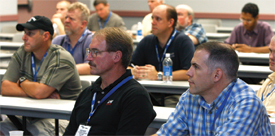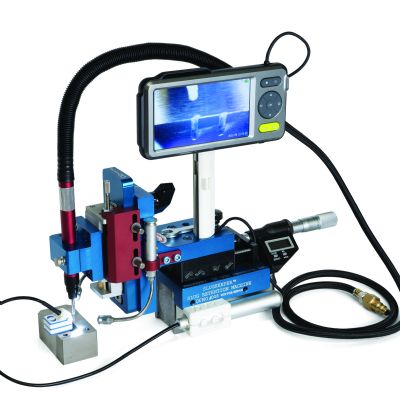Die Planning, Estimating and Sourcing Strategies—Jeff Bennett, Tool Planners
Techniques and software that improves the overall speed, accuracy and consistency of the production-planning and estimating process.
• Selecting the best stamping process for your part;
• How to create die concepts quickly using basic desktop tools;
• Software solutions for estimating dies and production parts; and
• The 4 Ps of successful die outsourcing.
Clearing the Springback Hurdle—Eric Kam, AutoForm Engineering GmbH
How to recognize the elements of product design and manufacturing that lead to springback. Methods for predicting, resolving and living with springback will be discussed, as will:
• Computer simulation as a tool for predicting, evaluating and combating the effects of springback;
• The challenges presented by advanced high strength steels; and
Springback.
Session S21Sensors and Controls for Metalforming I
Extreme Lean: Eliminating Expensive Dies and Assembly Processes with Right-Sized Tooling and Mistake-Proofing Sensors—George Keremedjiev, Tecknow Education Services
The latest approaches in the use of electronic sensors and controls for mistake-proofed tooling, machinery and controls, available at e a fraction of the cost of conventional metalforming and assembly processes while providing true flexibility and profitability.
• Rethinking tooling: Eliminating/ minimizing the need for expensive progressive dies;
• Intelligent assembly: Low-cost, self-adapting value-added processes; and
• Fully sensored: Mistake-proofing for truly lean metalforming and assembly operations.
Session S22 Metalforming Press System Optimization I
Evaluating and Improving Preventive-Maintenance Inspections —Peter Campbell, Campbell Press Repair
Slow times provide a good opportunity to refocus on PM inspections, so that when work picks back up, your presses will be ready to get the job done.
• Where to look for early signs of problems;
• Simple items to add to your PMs that will offer great payback; and
• New technologies that can be used to detect unseen problems.
Options for Press Repair and Modernization—Peter Campbell, Campbell Press Repair
This presentation sheds light on where presses tend to fail and what parts will be affected if maintenance is deferred.
• What parts typically break on a press;
• What are some of your options when a failure occurs; and
• What you can do to avoid common mistakes in press operation.
10:30 a.m. – 12:30 p.m. Session S30 Stamping Advanced High Strength Steels II
Gaining a Competitive Advantage through In-Die Fastener Installation Systems—Roger Patton, PennEngineering
A multimedia presentation including detailed animations of the in-die fastening process and several case studies.
• Why in-die fastener-insertion systems add value;
• How in-die fastener-insertion systems work;
• Determining the ROI of in-die systems; and
• Proper implementation of an in-die system.
Designing Dies for High-Strength-Steel Stampings—Peter Ulintz, Anchor Manufacturing Group, Inc.
Recent die-process research has proven the effectiveness of several unique methods that address problems specific to advanced high-strength steels, including the selection of optimum stamping processes and equipment, solving formability issues, controlling springback, selecting die steels for optimal tool life and establishing product-design strategies to ensure manufacturability.
• Die-design considerations;
• Die maintenance considerations;
• Pressroom considerations; and
• Methods for managing springback.
Session S31
Sensors and Controls for Metalforming II
Sensors for Die Protection—James Finnerty, Honeywell-Wintriss
Describes the two types of sensors most suitable for in-die measurement; the advantages and drawbacks of each; and application examples including die diagrams and photographs showing successful in-die measurement sensor installations.
• Step-by-step procedures for calibration;
• Wiring guidelines and mounting techniques;
• Why some sensors work and others don’t;
• Get the most out of your control system; and
• Avoid the most common pitfall of sensor installation.
1:30 – 3:30 p.m.
Session S40 Sensors and Controls for Metalforming III
Getting to Servo Controls—Steve Heitman
Vision Systems, Tools for Quality Improvement—David Fletcher, RR Floody Co., Inc. (Cognex)
Learn how to:
• Improve product quality with vision sensing to meet zero-tolerance;
• Use vision sensors in the pressroom; and
• Use image capturing and measurement data for process traceability.
Tuesday, November 17
8 – 10:00 a.m.
Session S50 Selecting Tool Steels for Metalforming I
Tool Steel Considerations for Lean Manufacturing Operations—
Gary Maddock, Zapp Tooling Alloys
Steel selection for reliable performance or for failure prevention can reduce non-productive time needed for tool changes or tool maintenance.
• Applying lean principles when considering tool steels;
• Reviewing tool performance to identify failure modes;
• Selecting tool steel to minimize performance interruptions; and
• Maximizing tool-performance reliability.
The New “Standards” in Tooling Steels for Advanced Cold Work Applications —Patricia Miller, Bohler-Uddeholm Corp.
A look at several new and interesting tool-steel developments that will enhance the productivity of today’s workplace, including case studies that illustrate significant performance improvements.
• The latest production techniques in tool-steel development;
• The newest alloys in tougher, more wear-resistant grades than A2 and D2;
• A new anti-galling grade than can eliminate the need for coatings; and
• New high-strength weldable tool steels and castable alloys.
Session S51Press Line Technology I
Creating a Multipurpose Press Line Using Servo-Transfer Technology—Douglas Knapke, ne Trail Technologies
How to effectively implement a servo-transfer system for productivity and flexibility gains, including case studies to illustrate how to gain additional press and press-bed size capacity by selecting the right type of servo-transfer system.
• Gain productivity and profitability by adding servo-transfer technology to existing presses;
• Increase press capacity and flexibility to capture virtually any type of stamping work; and
• Identify the best transfer solution for your applications and presses.
Business Dynamics—Impact on the Selection of Coil-Processing Equipment —Jeff Gerken, Automatic Feed Company
Material utilization, the increased use of advanced high-strength steels, a focus on energy savings, and flexibility to address partial coil runs impact decision makers when selecting coil-processing equipment.
• Basic and advanced line configurations;
• Hit-to-hit and line-loading
• How raw materials affect equipment selection;
• Coil-management and finished-part-storage systems;
• Nontraditional approaches using continuously fed laser-blanking systems; and
• Criteria for equipment running steel and aluminum on the same line.
Session S52 Lean Manufacturing Principles for the Pressroom I
A Case Study Using Root-Cause Analysis Software to Eliminate Costly Die Rework—Murray Desnoyer, Origin International Inc.
A case study to launch a stamped part walks attendees through the complete analysis and corrective action taken to successfully fix the stamping with just the additions of a few shims vs. sending the die back to the tool shop for rework.
• How advanced root-cause analysis software can correct a stamping process;
• Best-fix simulation cuts launch iterations to only one;
• Eliminate scrap and sorting from stamped-part manufacturing; and
• How to use multipart SPC data to correct a stamping process.
10:30 a.m. – 12:30 p.m.
Session S60 Selecting Tool Steels for Metalforming II
Tool-Steel Failure Analysis—James Angelo, Dayton Progress Corp.
This presentation discusses the causes of point wear, bending and chipping, and head breakage and galling, as well as the solutions to reduce or prevent these failures.
• Identify different types of failures in tool steels;
• Determine the cause of the failure; and
• Recommend solutions to reduce or prevent failures.
Tool Steels for Stamping High Strength Materials—Nick Tarkany, International Mold Steel
A systematic approach to tool-steel selection, heattreat, and die design to optimize trim and pierce punches and dies for stamping high-strength materials.
• Compare tool steels and required properties to trim and pierce high-strength materials;
• Understand and optimize tool-steel life through sound heattreat practices; and
• Evaluate design considerations for trim and pierce tooling.
Session S61 Press Line Technology II
Why Servo Drive is Europe’s New Standard—Recent Technology Advances and Commercial Cases—Andy Osborn, Schuler Inc.
A review of actual production data for more than 10 commercial parts produced on an eccentric and a servo-drive press shows significant increases in production rates with servo.
• Productivity gains from servo technology for a variety of parts and press tonnages,100-1000 tons;
• Impact and considerations for dies and peripheral equipment; and
• Reducing energy consumption with a servo-driven press.
Methods to Improve the Performance of Metalworking Machinery—Keith Leatherwood, Vibro/Dynamics Corp.
Explains basic machine structural dynamics and vibration theory using technical illustrations and case studies, and describes the characteristics of a variety of isolators and mounting systems, including elastomeric, coil spring systems, material and viscous damping, leveling and nonleveling designs.
• Best machine-installation practices;
• Current installation technologies; and
• Machine structural dynamics and vibration theory.
Session S62 Lean Manufacturing Principles for the Pressroom II
Integrated Manufacturing and Business Processes Lead to Less Cost, Less Waste and Improved Efficiency —Mark Symonds, Plex Systems
Learn from two manufacturing IT leaders how integrated systems have helped their metalforming companies improve product quality and traceability, reduce waste, and save time as move to integrated systems.
• How and why to integrate IT and manufacturing and business processes;
• Case studies;
• The value of having information updated automatically and made accessible to all employees; and
• How integrated systems/information improves traceability and quality.
Wednesday, November 18
8 – 10 a.m.
Session S80 Cleaning and Lubricants for Stamped Parts I
Cost Benefits of High Performance Lubricants—Steve Lowery, Tower Oil & Technology Co.
Through the use of real-world issues facing stampers, case studies and several cost justification techniques will be reviewed, including a detailed cost analysis.
• Selecting high-performance lubricants;
• Tooling wear versus press uptime;
• Cost-evaluation techniques; and
• Case studies.
Cleaning Stamped Parts—Lloyd Hundley, Tower Oil & Technology Co.
This session will leave the participant with the understanding of cleaning methods relating to stamped parts.
• Realize cost savings by evaluating the entire stamping process;
• Relationship of stamping lubricants and cleaning methods;
• Selection and limitations of proper cleaning chemicals and processes; and
• Post processing—rust protection and painting.
Session S81
Pressroom Safety I
New ANSI B11.1-2009 Mechanical Power Press Standard—Jim Barrett, Link Systems
As press production systems have become more complex and diverse, the new standards emphasize the need for analysis to determine hazards associated with auxiliary equipment and automation. They also address perimeter guarding of press production system areas where multiple hazards exist for the first time.
• Requirements of the new ANSI B11.1-2009 standard;
• Emphasis on hazard analysis for auxiliary equipment and automation;
• Perimeter guarding of press production system areas where multiple hazards exist for the first time.
10:30 a.m. – 12:30 p.m.
Session S90 Cleaning and Lubricants
for Stamped Parts II
Hydrocarbon Cleaning Technology—Fred Thompson, Durr Ecoclean
• What is hydrocarbon part cleaning technology?
• Why the need for this technology was developed;
• Common facts about hydrocarbon fluids;
• Advantages of this new technology; and
• Case studies.
Session S91 Pressroom Safety II
Risk Assessment for the Press Room —John Peabody, Omron STI
Methods to perform a machine-safeguarding assessment and how to use factors of risk and hierarchy of controls to determine the requirements for the safety-related control system.
• Understand the value of a documented machine guarding assessment, and the key elements or factors of a risk assessment;
• Identify how to conduct a risk assessment;
• List the types of safety-control interfaces to use based on the information gained from the risk assessment;
• Understand the hierarchy of control required to reduce risk;
• Identify risk-assessment report requirements.
OSHA Compliance Requirements for Revised Standards—Speaker TBD
To register, visit www.fmafabtech.com/ registration.cfm or use the registration form on page 45-46. MF
Technologies: Software, Stamping Presses, Tooling








 Video
Video
